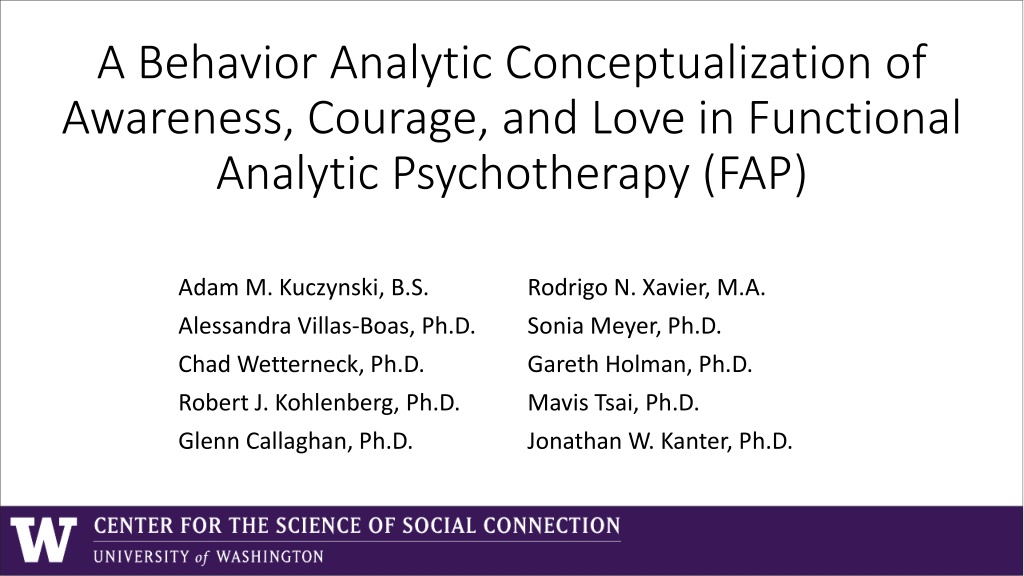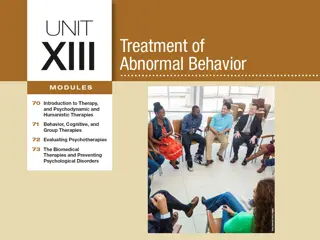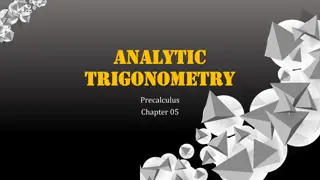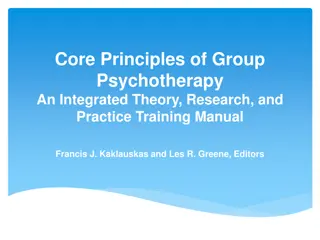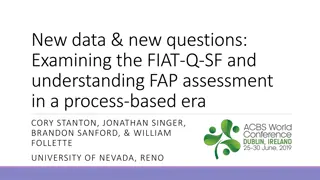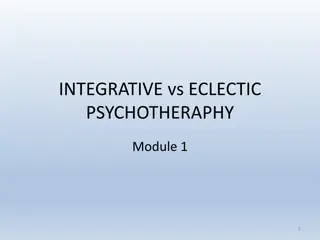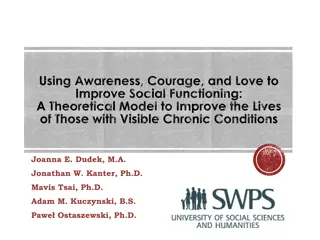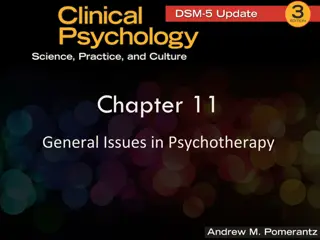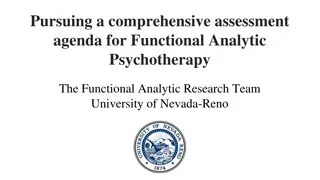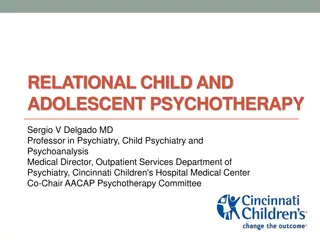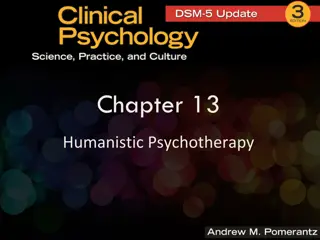Understanding Functional Analytic Psychotherapy (FAP) Concepts
Delve into the Behavior Analytic Conceptualization of Awareness, Courage, and Love in Functional Analytic Psychotherapy (FAP). Explore the principles of FAP, including clinically relevant behaviors, the therapeutic relationship, and the five rules guiding the practice. Discover how FAP targets behaviors through operant processes, emphasizing client and therapist collaboration for meaningful outcomes.
Download Presentation

Please find below an Image/Link to download the presentation.
The content on the website is provided AS IS for your information and personal use only. It may not be sold, licensed, or shared on other websites without obtaining consent from the author. Download presentation by click this link. If you encounter any issues during the download, it is possible that the publisher has removed the file from their server.
E N D
Presentation Transcript
A Behavior Analytic Conceptualization of Awareness, Courage, and Love in Functional Analytic Psychotherapy (FAP) Adam M. Kuczynski, B.S. Rodrigo N. Xavier, M.A. Alessandra Villas-Boas, Ph.D. Chad Wetterneck, Ph.D. Sonia Meyer, Ph.D. Gareth Holman, Ph.D. Robert J. Kohlenberg, Ph.D. Mavis Tsai, Ph.D. Glenn Callaghan, Ph.D. Jonathan W. Kanter, Ph.D.
Can you please get me a glass of water? A Brief Account of Verbal Behavior Manding and Tacting That is a large glass of water! The Tact The Mand In other words In other words verbal behavior you engage in directly in response to a particular stimulus in your environment AND that is reinforced generally A verbal operant in which a response of given form is evoked (or at least strengthened) by a particular object or event or property of an object or event. (i.e. not specific to the particular stimlus in your environment) A verbal operant in which the response is reinforced by a characteristic consequence and is therefore under the functional control of relevant conditions of deprivation or aversive stimulation condition verbal behavior you engage in because you are in a state of deprivation or are in contact with some aversive stimulus AND that is reinforced by something specific to that
A Brief Introduction to FAP: What is it? FAP is a contextual behavioral therapy that Targets clinically relevant behaviors (CRBs) as defined by the client and therapist Uses the therapeutic relationship to shape CRBs through operant processes
A Brief Introduction to FAP: Clinically Relevant Behaviors (CRBs) CRB2 Client improvements that occur in session CRB1 CRB3 Client functional interpretations of own behavior e.g., Wow, it blows my mind that I can get so upset in here and you tolerate it. My dad would have run screaming! Client problems that occur in session e.g., making eye contact, listening intently to therapist e.g., failure to make eye-contact, talking over therapist
A Brief Introduction to FAP: The Five Rules Rule 1 Rule 1: Watch for CRBs Rule 2 Rule 2: Evoke CRBs Rule 3 Rule 3: Reinforce CRB2s Naturally Rule 4 Rule 4: Observe Your Impact in Relation to Client CRBs Rule 5: Provide Functional Interpretations and Generalize Rule 5
A Brief Introduction to FAP: The Five Rules
A Brief Introduction to FAP: The Five Rules Be AWARE of your client s CRBs Rule 1 Rule 1 COURAGEOUSLY evoke your client s CRBs Rule 2 Rule 2 LOVINGLYrespond to your client s CRB2s Rule 3 Rule 3 Rule 4 Rule 4 Be AWARE of your impact on your client s CRBs Rule 5 Rule 5 Generalize (behaviorism)
What are Awareness, Courage, and Love? Categories of Potential CRBs Awareness Behavior that brings into focus key antecedent stimulus conditions for social connection behavior (e.g., noticing your feelings, noticing others boredom) Courage Behavior that is vulnerable to interpersonal punishment in the service of values related to interpersonal connection (e.g., sharing your feelings, setting boundaries) Love Responding to another s courage behavior with attunement and sensitivity to what is naturally reinforcing in the moment
What are Awareness, Courage, and Love? Intimacy as an Interpersonal Process Reis & Shaver (1988) Responsiveness (understanding, validation, caring) Awareness Vulnerable self-disclosure Responsiveness (understanding, validation, and caring) Vulnerable self-disclosure C T Responsiveness (understanding, validation, caring) Vulnerable self-disclosure Responsiveness (understanding, validation, and caring) Vulnerable self-disclosure
What are Awareness, Courage, and Love? Context: Interpersonal interaction with motives and needs related to connection/closeness Consequence (understanding, validation, caring) Response/behavior Vulnerable self-disclosure C T
What are Awareness, Courage, and Love? Context: Interpersonal interaction with motives and needs related to connection/closeness Consequence/reinforcer Love Response/behavior Courage C T
Awareness, Courage, and Love Awareness Awareness A C B Interpersonal Interaction Transformed (more effective) stimuli conditions Attention
Awareness, Courage, and Love Courage & Love Speaker Courage Reinforcement B A C Client Idiosyncratic Interpersonal Interaction Love (from therapist) B Idiosyncratic C A Therapist Client s situation has improved Interpersonal Interaction Speaker s courage behavior Love
Awareness, Courage, and Love Self Love Self Love ESTABLISHING OPERATION Aversive stimulation in the form of punishment of one s courage behavior OR Deprivation in the form of a lack of reinforcement for one s courage behavior A B C Interpersonal interaction and ineffective courage behavior Idiosyncratic Your situation has improved
The Entire Model Awareness B Attention Transformed (more effective) stimuli conditions A C Interpersonal Interaction Courage A C B Client Interpersonal Interaction Love (from therapist) Idiosyncratic C B A Therapist Client s situation has improved Idiosyncratic Interpersonal Interaction Speaker s courage behavior Love Self-Love B Idiosyncratic A Establishing Operation C Interpersonal interaction and ineffective courage behavior Client s situation has improved
ACL in Practice Awareness Response Your present-moment self (your body, thoughts, feelings) Your values, needs, goals, identity, impact of your history The other: empathy (impact of their history) Your impact on the other person Evoke courage and love behaviors (i.e. expression of awareness) Help client experience automatic benefits of awareness Courage Love Experiencing vulnerability and emotion Speaking your truth (tacting) "Asking for what you need (manding) Closeness and Connection Setting boundaries Asking for support Asking for difficult feedback Giving difficult feedback Asking for appreciation Acceptance, providing safety & reciprocal vulnerability Expressing understanding, empathy, and validation Giving others what they need (specific things) Providing closeness and connection Respecting boundaries Providing support, promising Providing feedback Responding to difficult feedback Expressing appreciation Response Express to the other that you are helped by their love appreciate them feel more connected to them
ACL in Practice Awareness Response Your present-moment self (your body, thoughts, feelings) Your values, needs, goals, identity The other: empathy Your impact on the other person Evoke expression of awareness (i.e., courage and love behaviors) Help client experience automatic benefits of awareness Self-Love Response Acceptance of yourself (awareness, self-compassion) Accepting caring and loving feelings from others Cultivating positive feelings in yourself (appreciations, pride) Self-care (activities that soothe, calm, rejuvenate, recharge, or bring pleasure) Courage Love Deep acceptance, providing safety Modeling and joining Experiencing vulnerability and emotion Speaking your truth (speaking from the heart) Asking for what you need Closeness and Connection Setting boundaries Asking for support Asking for difficult feedback Giving difficult feedback Asking for appreciation Acceptance, providing safety & reciprocal vulnerability Expressing understanding, empathy, and validation Giving others what they need (specific things) Providing closeness and connection Respecting boundaries Providing support, promising Providing feedback Receiving difficult feedback Expressing appreciation Response Express to the other that you are helped by their love appreciate them feel more connected to them
Future Directions As behaviorists, it is important that our interventions are designed around behavioral principles that will allow us to predict and influence behavior, but Purely principle driven treatments are difficult to train to non-behavior analysts and Research is difficult on non-manualized treatment programs
Future Directions The ACL Manual Creating a manualized FAP protocol will Maintain a focus on behavioral principles and function and Will provide Researchers and clinicians of all levels of expertise with a clear and precise guide for using FAP in research and with their clients
Coming up next Joanna, Michael, and Mavis will provide more specific theoretical models and research using the ACL Model of FAP
Thank You Adam Kuczynski adamkucz@uw.edu
